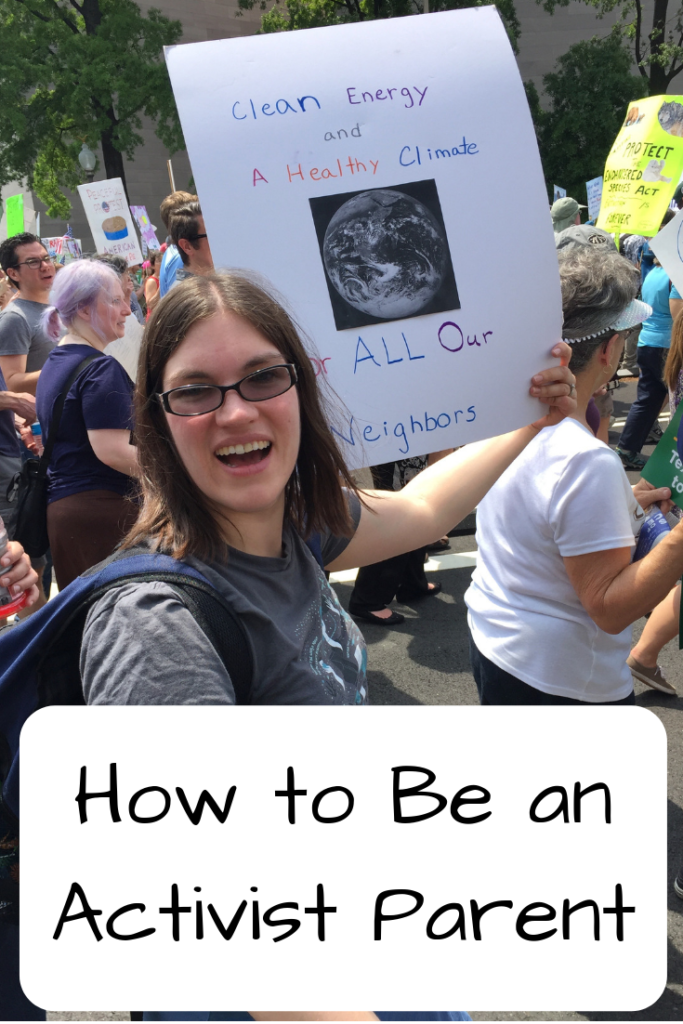
“I know there’s no guarantees, but this is the group that probably won’t get arrested, right?” I asked our leader as we stood outside of Union Station in Washington DC.
“Yes, that group already left,” he said, smiling. I breathed a sigh of relief. If I was going to get arrested for protesting climate change, I needed to make more accommodations than just getting a half-day off from work.
As someone who has been passionate about climate change for more than a decade, I’ve participated in my share of protests and political actions. Since becoming a mom, I’ve adjusted my participation accordingly. Here’s what I’ve learned about being an activist parent:
Pick an area of focus
My big area of focus is climate change, because it’s the meeting place of my two passions of social justice and environmental issues. I participate in some level of activism for other issues, such as racism, economic justice, feminism, and LGBT rights, because I care about them and they all intersect in different ways. But the majority of the meetings, protests, and in-person actions I attend are focused on climate change or issues that contribute to it. Without a focus, it’s easy to get overwhelmed and not take any action.
Know your limits
That morning, I went into the protest planning not to get arrested. As a sole income-earner for my household, not showing up at work because I was arrested could cause some serious financial issues for my family. In other circumstances, I might consider it if I felt like the risk was going to have a big enough impact.
Getting arrested or not isn’t the only thing to consider. There are also physical and emotional limits. When I was pregnant, I left a march against the Keystone XL pipeline early because I had to pee. When I attended a climate march with my kids, we ducked out before we reached the White House because it was just way too hot. There are lots of ways to participate in activism if you have issues that prevent you from attending something in person. In fact, many of these activities, like calling policy makers, fundraising, and organizing volunteers, have more on an impact over the long-term than showing up to a protest once in a while.
Set boundaries
It’s easy for activism to become all-consuming. Just like parenting, there’s always more to do. The stream of marches, rallies, petition, and meetings can seem endless. For the first few years of my kids’ lives, I set a standard that I wouldn’t miss dinner and bedtime with my kids more than once a month. I’ve eased up on that a bit, but try to be protective of that time. Pick a specific time or place that you engage in activist activities and make other time/places protected to not do so.
Recognize burnout before it happens
Even with all this, it’s easy to experience burnout, especially emotional burnout. The topics that activism focuses on are frequently frustrating and depressing. They’re generally long-term problems with no easy answers. It can be even more difficult if you’re personally affected by the issue at hand. Watch out for apathy, resentment, and bitterness when you’re participating. Self-righteousness is another big sign, especially towards people you love. If you are an ally (not a direct member of the affected group of people), these attitudes can lead to a savior or “going through the motions” mentality, where your attitude and focus becomes more about you than listening to the populations of people you are standing with.
Keep in mind why you do it
One of the best ways to prevent burnout is keeping a positive vision of the world we’re working towards. For most parents, that’s going to be a world for our kids and all kids that’s more just and sustainable than the world we live in today. Remembering that big picture can help when it feels like we’re drowning in the million little actions needed to make change.
Consider involving your kids
Getting your kids involved can send a powerful message to them about the difference they can make. From the protests against gun violence in the U.S. to the student strikes against climate change in Europe, student activism has risen drastically in the past few years. Some events even welcome kids. We saw many other families at the climate march and they had some nice kid-focused art activities at our local climate rally last year. In terms of meetings, an increasing number are starting to recognize the importance of providing child care or making meetings kid-friendly. If there are no groups around you that do that, see if there are any other members of the group who have children and would like to switch off babysitting duties.
Multi-task when possible
Parents are masters of multi-tasking. I know some folks make phone calls to policy makers and volunteers while they’re folding laundry. (And there’s always more laundry.) I call my Congressional representatives in the five minute walk from work to the Metro and sign email petitions in the car while my husband is driving.
There’s a famous quote by Alice Walker, the author of The Color Purple, that says, “Activism is my rent for living on the planet.” As someone with an immense amount of privilege, I feel like that goes double or triple for me. Thankfully, it is still possible to be a mom and activist, even if it looks a little different than it used to.
For more on the intersection between parenting and social justice, follow us on Facebook and join our Green and Sustainable Parenting community!